Springtime is galaxy time. Only 30 million light years away, the Leo I Group and nearby Leo Triplet entice the eye with an assortment of bright spiral and elliptical galaxies.
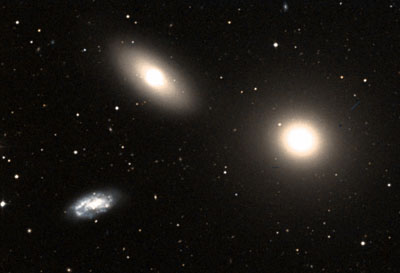
Sloan Digital Sky Survey-II
Welcome to spring! The new season begins (or began depending on when you read this) at 5:58 p.m. EDT on March 20th. That's also the night of the full moon, a perfect time NOT observe today's featured galaxies. But the March Moon hurries southward and soon departs the sky, opening a lengthy dark-sky window beginning Friday the 22nd.
Leo the Lion stands high in the southeastern sky at nightfall this month, flinging galaxies our way like a clown tossing Tootsie Rolls at a parade. Point your scope in the right direction and you're bound to catch a few. We'll focus on the Leo I Group, a cluster of galaxies located about 30 million light-years from Earth. There are a couple things I love about this group — the members are all on the bright side (around magnitude 10), and you can observe the entire bunch in one viewing session.
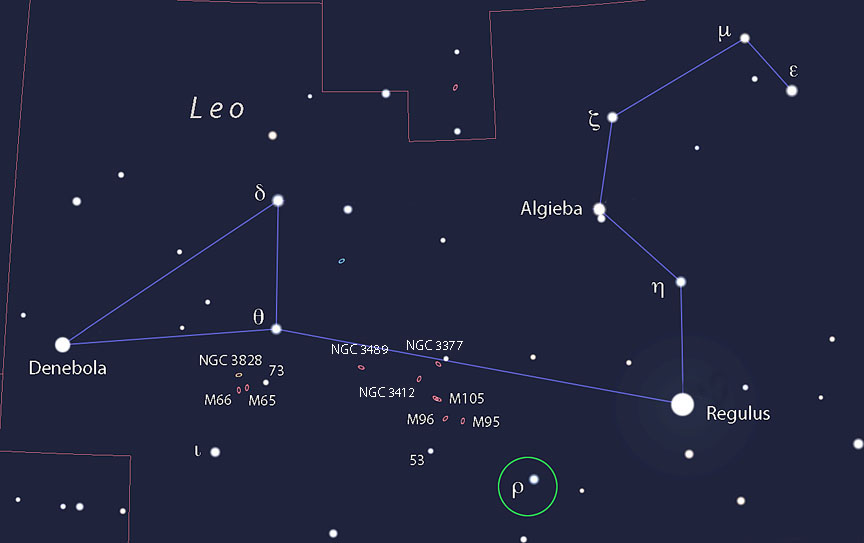
Stellarium
The Leo I Group, also called the M96 Group, is centered on the bright Messier galaxies M96 (magnitude 9.3) and M95 (magnitude 9.7), located 4° northeast of 4th magnitude Rho (ρ) Leonis. Various sources list anywhere from seven to nine members, but a recent deep survey turned up three dozen additional faint dwarf galaxies, including several rare ultra-diffuse galaxies. The latter are similar in size to the Milky Way but contain only a fraction as many stars. The striking Leo Triplet of M65-M66-NGC 3628 lies just 7.5° east of the core group and may be physically connected to Leo I; all three have similar distances and radial velocities. We'll add those to the mix, too.
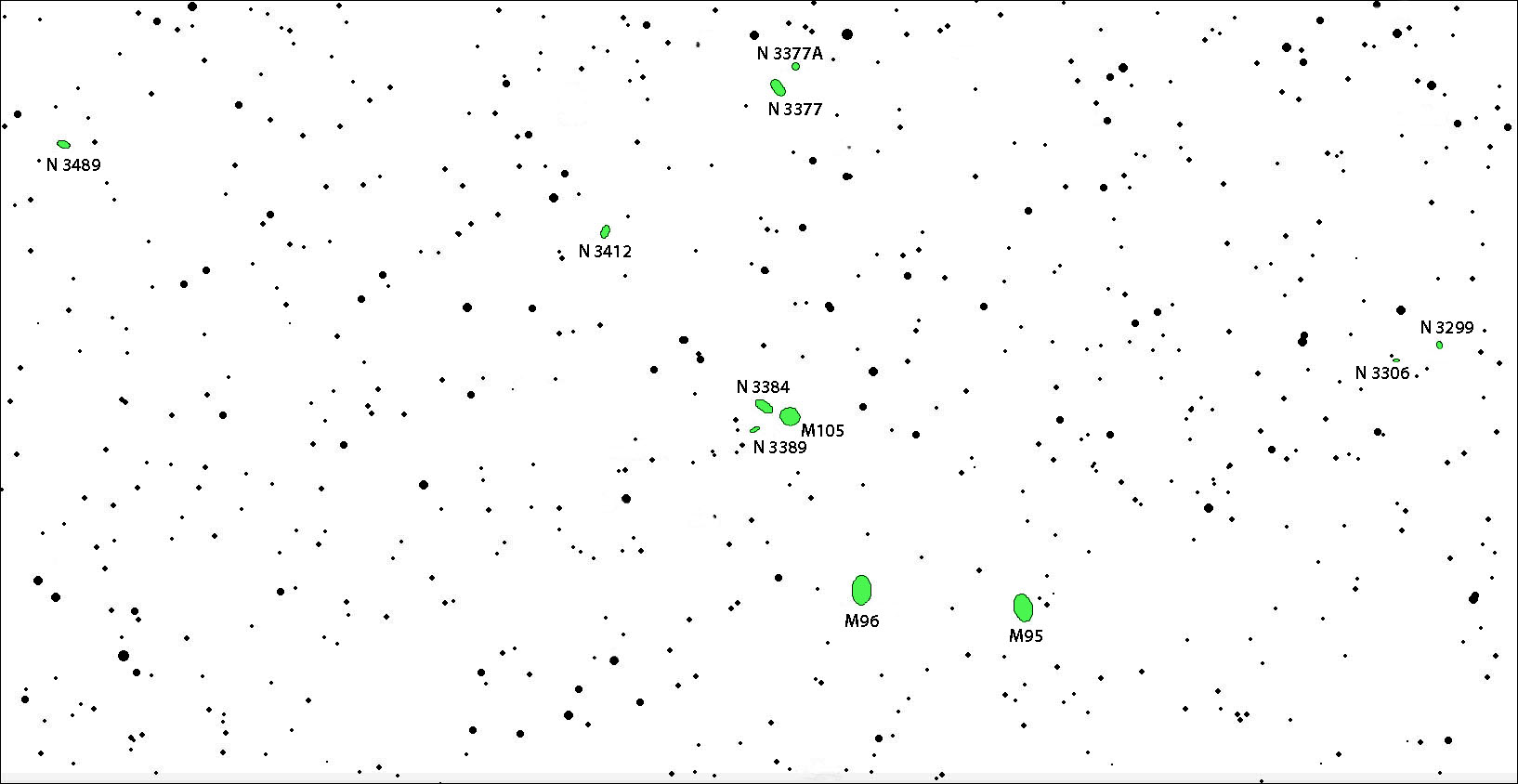
Chris Marriott's SkyMap
Center Rho (ρ) Leonis in your finder and you'll have little difficulty spotting the M95-96 pair 4° north-northeast. Both are barred spirals and fit comfortably in the 64x field of view of my 15-inch Dob. M95 is round with a bright, compact nuclear region and faint stellar nucleus. At 242x the disk appeared mottled with averted vision, but I couldn't distinguish either the bar or the faint spiral arms peeling off either side of the central disk and extending to the north and south.
M96 is the largest galaxy in the group. It's similar in size to the Milky Way, with a diameter of 100,000 light-years. An 11.5-magnitude near-stellar nucleus glares from within the galaxy's bright, extended inner disk. But something kept bothering me as my eye roved back and forth across the scene. Then it hit me — the inner disk appeared askew, oriented approximately east-west inside the fainter, north-south elongated outer disk. Aha!
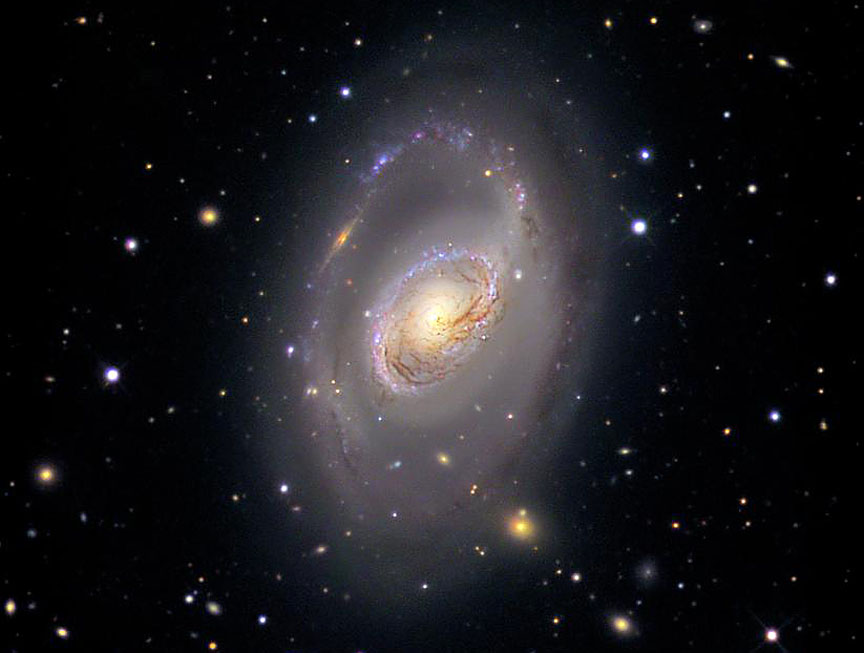
Adam Block
Gravitational interactions past and present with other members of the Leo I group have warped M96's disk and drawn out a spiral arm rich with new star-forming regions. With 242x and averted vision, I saw the bright, innermost section of this arm as a faint stub of light extending a short distance northwest of the nuclear disk. On a night of good seeing, M96 is anything buy stingy on detail and makes a great target for high-magnification exploration.
Next, we come to the "Eyes," a delightful close pairing of the elliptical galaxy M105 and its lenticular neighbor NGC 3384 located just 7 arcminutes to the northeast. Both are nearly equally bright with magnitudes of 9.7 and 10 respectively. You might also catch a glimpse of faint pretender NGC 3389 (magnitude 12.8), a faint but unrelated spiral galaxy that's 9.5′ southwest of M105. This tight trio makes a wonderful sight huddled together in the same field of view at medium and high powers.
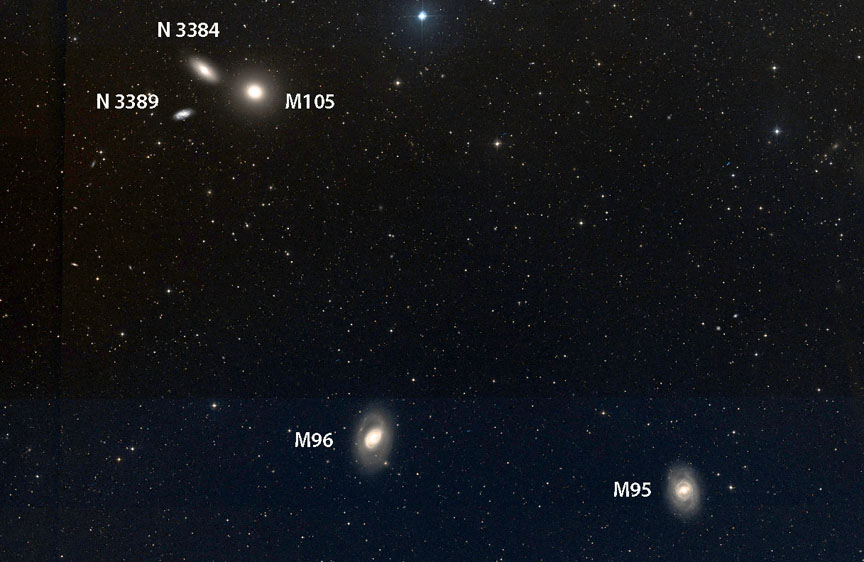
Sloan Digital Sky Survey-II
Both M105 and NGC 3389 appear smooth and diffuse with prominent near-stellar nuclei. M105 is round, while NGC 3389 is clearly oval. Deep within M105's bright core, astronomers have identified a 200-million-solar-mass supermassive black hole. As you take in the view, the invisible beast waits for its next snack to cross the event horizon.
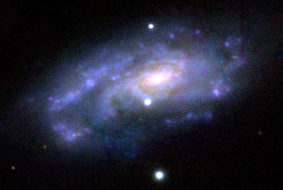
Pan-STARRS1 / CC 2.5 Generic
NGC 3389 immediately struck me as odd. A nub of a thing tipped northwest-southeast and asymmetrically bright, its west end glowed brighter than the east. Later, in studying photos of the galaxy, I realized that the bright nuclear region appeared off-center to the west because a large spiral arm extends in the opposite direction like the claw on a fiddler crab, creating visual asymmetry. What do you see here? Can you discern the chunky arm?
NGC 3377 (mag. 10.4) lies 1.4° almost due north of M105 — a little nudge of the scope and you're there without need of a map. This elliptical galaxy displays a bright, near-stellar nucleus embedded within a bright, elongated inner disk set inside a 5′ x 3′ oval haze tipped northeast-southwest. Seven arcminutes northwest, look for NGC 3377A (likely unrelated but appears on some lists), a very faint 2-arcminute, amorphous glow of magnitude 13.6.
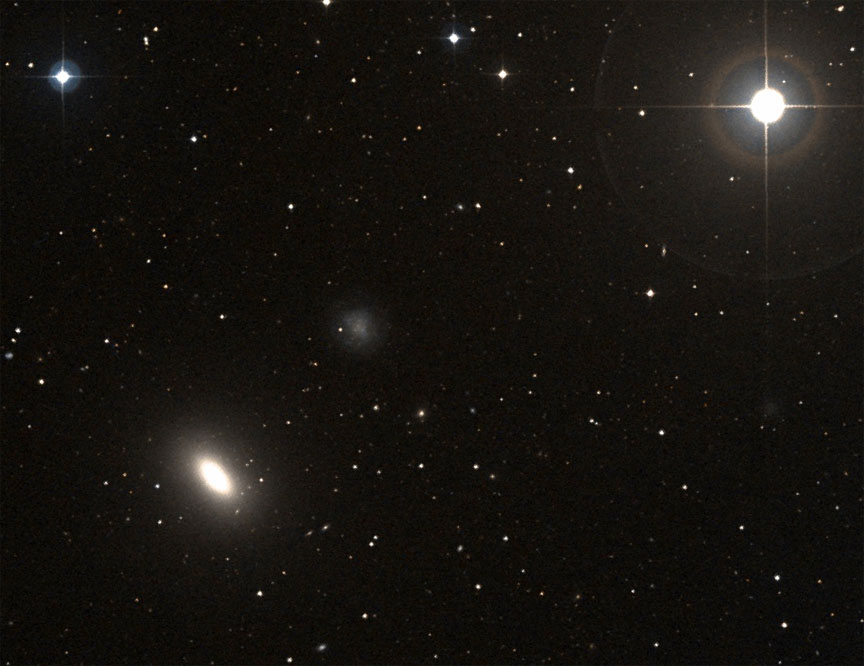
Sloan Digital Sky Survey -II
We move far afield to another possible group member, NGC 3299, located 3° southwest of NGC 3377. This one appeared as little more than a faint, diffuse patch of 14th magnitude, but it wasn't difficult to spot at 64x. Just 12 arcminutes southeast, I also found the unrelated galaxy NGC 3306 (magnitude 13.6), a small fuzz tipped northwest-southeast with a faint stellar nucleus.
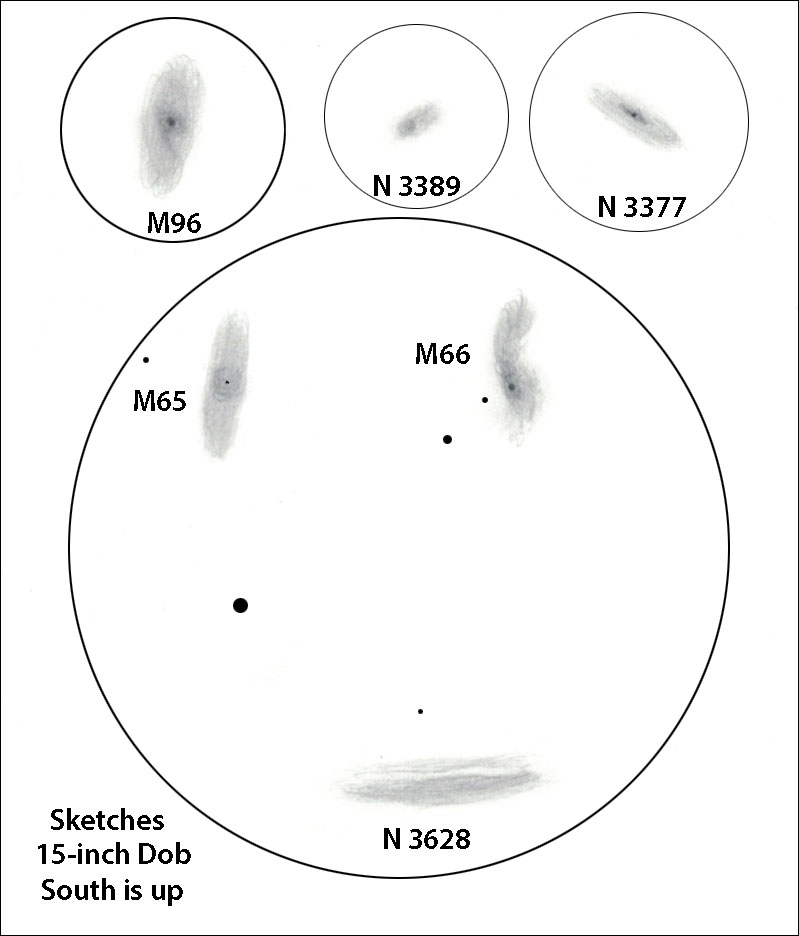
Bob King
We now swing back east to pick up two true group members, NGC 3412 and NGC 3489. The former is a 10.5-magnitude barred lenticular galaxy. It's 3.6′ x 2′ across with a bright, compact core set in a smooth, hazy lozenge of light that's tilted northwest-southeast. NGC 3489 (mag. 10.2), located 2.2° further east, is another lenticular with a bright, near-stellar nucleus and a brighter nuclear region. It's elongated east-west, though narrower than the other members of the group.
If bright nuclei and 10th-magnitude sound good to your ears, you'll be captivated by the Leo I Group. If you need brighter sights, something closer to the magnificence of the Grand Canyon, shift your scope another 7° to the east to the Leo Triplet. M66 is the showpiece here with one prominent, wide spiral arm reaching southward like a bent index finger. A much fainter arm extends to the east and north. M65 is a gorgeous galactic paramecium with an extended brighter core and tiny, faint stellar nucleus.
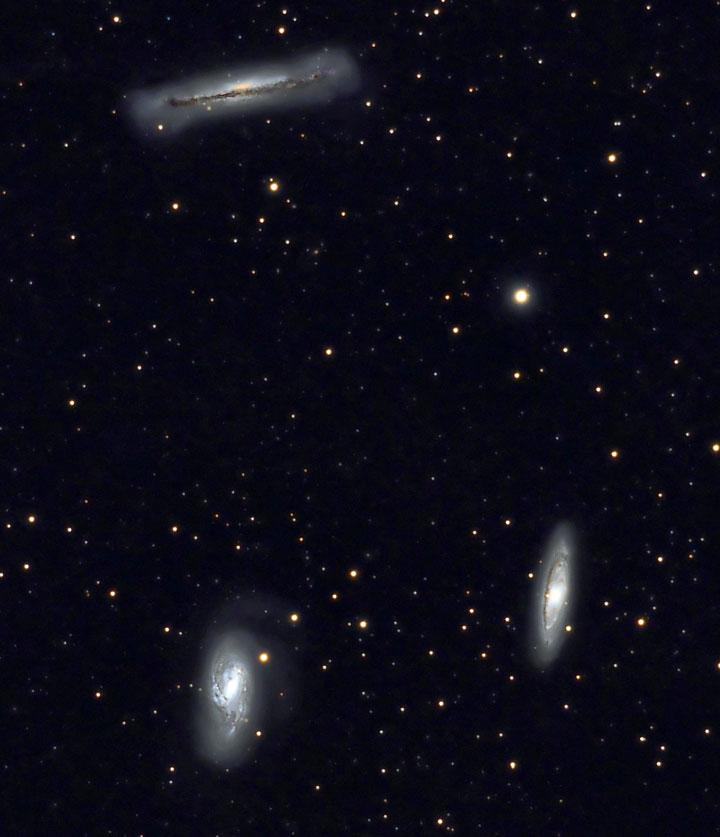
Hunter Wilson
You can finish off the triplet with a midnight snack that, despite its name, is suitable for carnivores and vegetarians alike — the aptly-named Hamburger Galaxy, NGC 3628. With averted vision and 142x, a dark lane — the burger — flits in and out of view between either half of the pale bun. All three galaxies fit with room to spare in a 1° field of view. They make for a sight that's certain to top off the night!
 9
9









Comments
Rod
March 20, 2019 at 1:22 pm
Bob, good charts and report for Leo. On March 4 and 12th, I was out late after 11:00 PM local time using my 10-inch Newtonian. M65, M66, and NGC 3628 were very good views at 35x and 86x, about 1.8-degree and 0.9-degree true field of view in the eyepiece. M95 and M96 too. In the past I viewed these galaxies using my 90-mm refractor but much better views with the 10-inch 🙂 I look forward to more observing in Leo after the Full Moon period, clouds, and likely rain coming departs my location 🙂 I really enjoyed viewing NGC 3628, a nice elongated shape easy to see in the 10-inch compared to the 90-mm refractor.
You must be logged in to post a comment.
Bob KingPost Author
March 21, 2019 at 12:01 pm
Hi Rod,
Thank you! I also like 3628 — one of the better dust lane galaxies.
You must be logged in to post a comment.
Tom-Reiland
March 20, 2019 at 2:02 pm
There's another galaxy to the WSW of NGC 3628, M65 and M66 that I always check out when I'm observing that trio. It's NGC 3593 and it forms a trapezoid with three stars. It's a little more than a degree from M65. This is the best season of the year for observing galaxies. From Ursa Major, through Canes Venatici, Leo, the Coma-Virgo region down into Corvus, Crater and Centaurus. I love it. Instead of star-hopping, I go Galaxy hopping.
You must be logged in to post a comment.
Bob KingPost Author
March 21, 2019 at 12:00 pm
Hi Tom,
And I love the warmer weather. My hands are much happier.
You must be logged in to post a comment.
Anthony Barreiro
March 21, 2019 at 6:34 pm
A small typo: the caption for the SDSS photo of NGC 3377 and 3377A refers to 3277 and 3277A.
I used to be able to see the brighter Messier galaxies through binoculars or a small telescope from the hilltop park near my home. Then San Francisco replaced all the streetlights with bright blue-spectrum LED's, and we launched into a frenzy of high-rise construction, each building striving to be brighter and more distinctive than the last. Sigh.
You must be logged in to post a comment.
Bob KingPost Author
March 22, 2019 at 10:17 am
Thank you, Anthony. Much appreciated! I've seen mostly poor use of the new LED technology as well. Overly bright and overly blue describes the majority of the lights in my city. But what I find even more appalling is the spread of poorly designed yard and "security" lighting that make homes look like gas stations at night.
You must be logged in to post a comment.
Anthony Barreiro
March 22, 2019 at 6:18 pm
We should at least require the vendors of outdoor lights to educate consumers about the harmful effects of light pollution and how to choose and install the right lighting for their needs. Giving consumers a rebate for buying night-sky friendly lights would help too.
You must be logged in to post a comment.
Bob KingPost Author
March 23, 2019 at 10:36 am
Anthony,
I really like the rebate idea. You'd have to get a hold of someone at Home Depot and Menards corporate headquarters and convince them it was a good idea. One that would improve their corporate image. I don't think that would be easy, but it wouldn't be impossible either.
You must be logged in to post a comment.
Anthony Barreiro
March 24, 2019 at 6:07 pm
Some states, municipalities, and utility companies offer rebates for energy-efficient appliances, so there would be a precedent. I wonder if the International Dark Sky Association has ever worked on this.
You must be logged in to post a comment.
You must be logged in to post a comment.